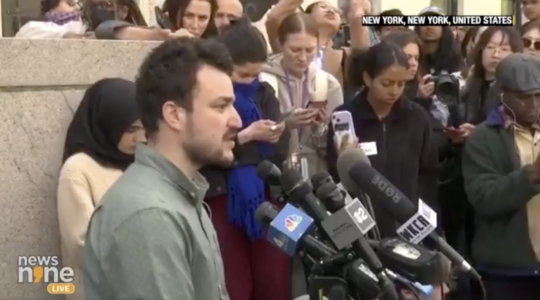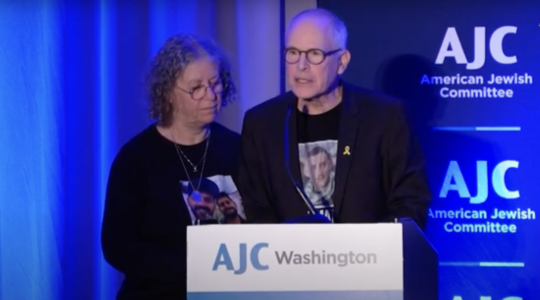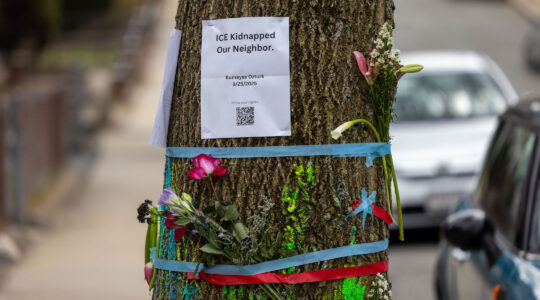NEW YORK (JTA) — For years, Rachel Light felt like a hostage, worried she would be forever trapped in her marriage to Eben Light.
Even in April 2012, after Eben was arrested for allegedly threatening her and was slapped with a restraining order, Rachel was unable to get a writ of Jewish divorce, or get.
That made her an agunah — Hebrew for “chained woman” — putting her in the company of hundreds of other Orthodox women who cannot remarry because their husbands refuse to grant them divorces according to Jewish law, or halachah.
Fortunately for Rachel, who was Modern Orthodox, she and her husband had signed a halachic (Jewish ritual) prenuptial agreement. In 2013, hers was the first such prenup to be enforced in a U.S. civil court. Light obtained her get and a substantial financial settlement in Connecticut.
“I’m so thankful that I happened to have signed it, because I don’t know that I’d be remarried today with an awesome, wonderful new family without it,” Light told JTA. “But nevertheless, it’s not going to be able to help everybody in every case, and I would love to see a solution that could.”
First developed in the 1990s in an attempt to protect women from becoming agunot, halachic prenuptial agreements stipulate that the couple in a dissolving marriage must come before a predetermined court of Jewish law. If the man refuses to provide the get, he must provide a financial settlement, typically in the range of $150 per day — an agreement enforceable in civil court.
Yet while halachic prenuptial agreements have been touted as a solution to the agunah problem, they have hardly been a panacea — because many are reluctant to sign them in the first place.
“Those who are most likely to need to use it are least likely to sign it,” said Rabbi Jeremy Stern, director of the Organization for the Resolution of Agunot, or ORA, which says it deals with more than 150 cases of agunot per year.
The problem is unique to the Orthodox world, because non-Orthodox movements have rejected or found ways around traditional rules that give husbands practically all the leverage. And, frustratingly for advocates on behalf of agunot, most Orthodox couples hail from segments of the community that aren’t interested in halachic prenups.
“The problem is in the black-hat and haredi community, where they don’t have prenups or rabbis don’t agree to enforce the idea of having a prenup,” said Stanley Goodman, director of an organization known as GET – Getting Equal Treatment.
Rabbi Avi Shafran, spokesman for the haredi Orthodox Agudath Israel of America, said Aguda does not advocate the use of halachic prenups.
“There is a concern that introducing and focusing on the possible dissolution of a marriage when it is just beginning is not conducive to the health of the marriage,” Shafran said. “I don’t think it is really possible to gauge their efficacy without data, and in any event, it would be impossible to know when the existence of a prenup might have eased the way toward a divorce when a marriage might, with effort and determination, have been saved.”
Even the centrist Orthodox Rabbinical Council of America, which reiterated its support for prenuptial agreements in a statement last week, does not require its member rabbis to request a halachic prenup before performing weddings.
“Rabbinic authorities that are guiding the RCA, with whom we consult, feel it is inappropriate to make an absolute obligation for members,” Rabbi Mark Dratch, executive vice-president of the RCA, told JTA.
The RCA’s public statement on prenups came on the heels of several high-profile cases of get refusal. In October, the FBI announced it had arrested a group of men in New York who were accused of taking money to use violence to compel recalcitrant husbands to give gets. Their methods allegedly included kidnapping and the use of electric cattle prods. Agunot were paying tens of thousands of dollars for the service.
In early November, the New York Post featured on its front page the story of an agunah from Lakewood, N.J., Gital Dodelson, who said her husband’s family had demanded $350,000 and custody of the couple’s son in exchange for a get. A storm of media coverage followed, prompting the husband’s father and uncle to temporarily resign from their positions at Artscroll, a leading Orthodox publishing house.
One of the main problems with the halachic prenup, advocates say, is the lack of enforcement of its financial penalties.
Although the agreements stipulate a daily fine to be paid by the husband to the wife while a get is refused, these fines are nearly always waived in exchange for the get itself, according to Rabbi Joel Weissman, director of the RCA-affiliated Beth Din of America, the religious court that oversees many agunah cases. In current versions of its halachic prenup, the Beth Din of America exercises absolute control over the payments and may waive them at its discretion.
“They’re emasculating their own prenuptial,” Susan Aranoff, co-director of the advocacy organization Agunah International, said of the Beth Din of America. “The way the Beth Din enforces it is a smokescreen that deprives the woman and does not protect her.”
In response, Weissman told JTA: “In a vast majority of cases, the woman will walk home with the get and not push the case for support.”
Rachel Light says it wasn’t until she took her agreement to civil court in New Haven that she was able to receive her get. Her then-husband had avoided multiple summonses to the beit din without any consequences, she said.
In such cases, the beit din, as an extralegal entity, has only one recourse: to issue a seruv, a religious contempt-of-court order akin to excommunication, in which the recalcitrant party is banned from participation in synagogues and other community institutions. In cases where individuals are indifferent to this exclusion, or communities are unwilling to cooperate, the seruv may be ineffective.
While civil courts have more tools at their disposal, that route presents challenges, too. Light’s case took a long time, cost a lot of money and ultimately did not guarantee that her husband would grant her a Jewish divorce — only that he would have to pay if he didn’t.
“I would love to think that our rabbis could come up with a more direct, protective solution, rather than a circuitous thing that maybe some rabbis will use and maybe some couples will sign — which you have to take to civil court anyway,” Light said of halachic prenups. “I would love to see our rabbis take this on full force and say this is something that we won’t allow.”
Judy Heicklen, president of the Jewish Orthodox Feminist Alliance, which will feature a session on agunot at its Dec. 7-8 conference in New York, says a Jewish legal solution must be found to obviate the need for enforcement in civil court.
“The prenup is not foolproof,” she said. “And on a philosophical level, we would hope that the halachah would be strong enough to find a solution within halachah and not have to rely on secular authorities to solve a human suffering issue that we should be able to solve within our own legal system.”
JTA has documented Jewish history in real-time for over a century. Keep our journalism strong by joining us in supporting independent, award-winning reporting.





